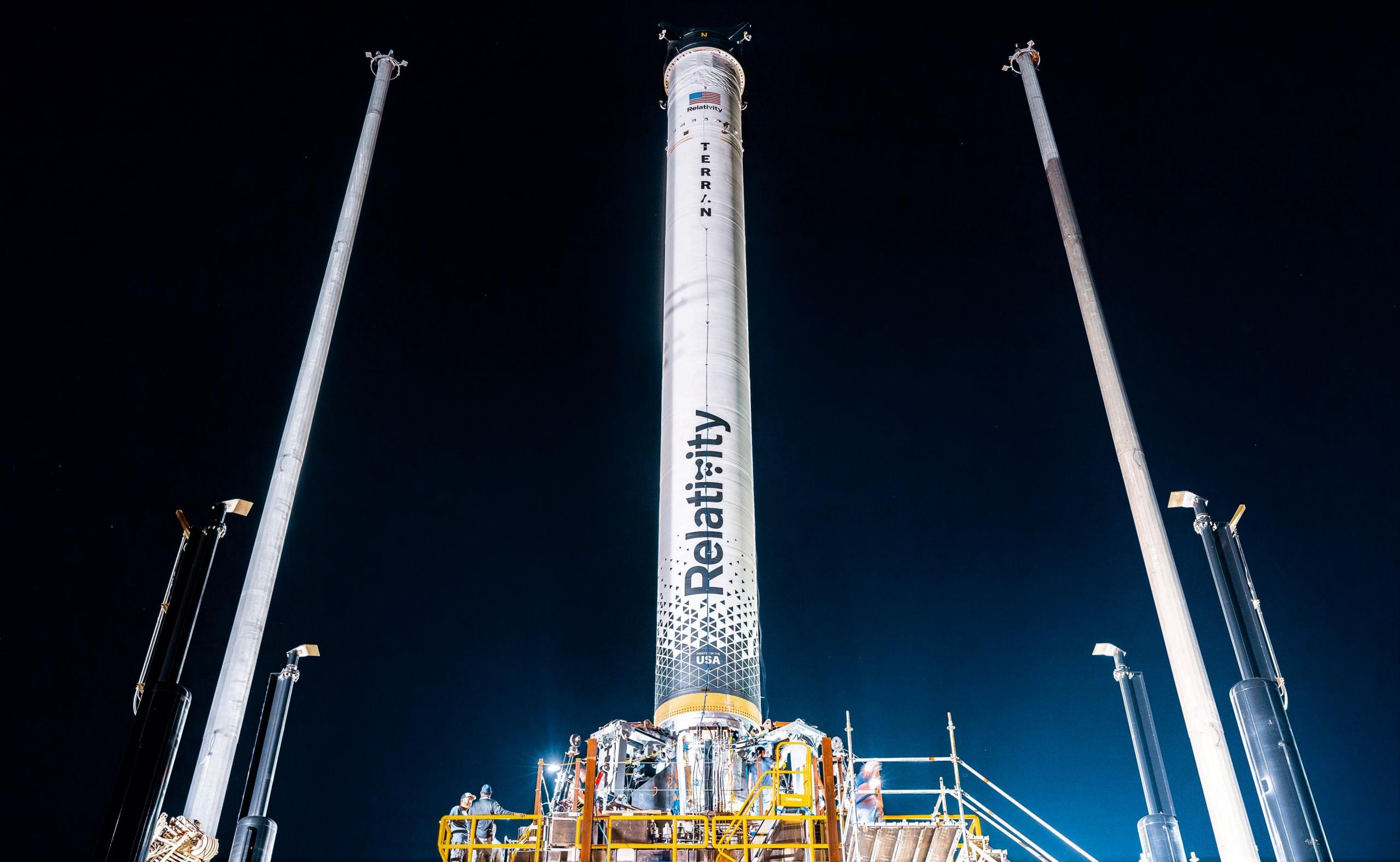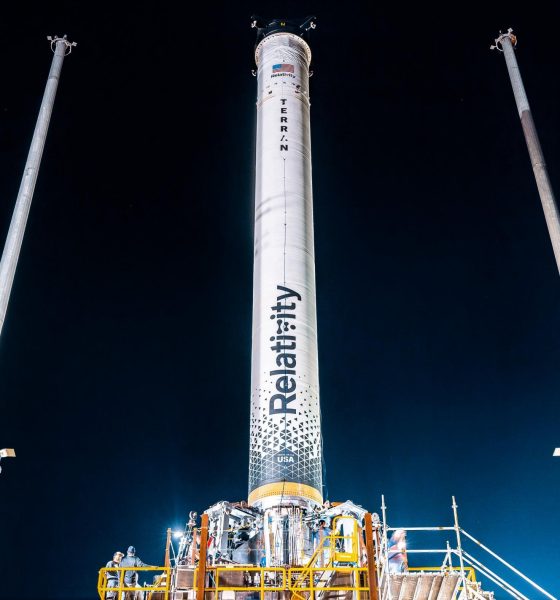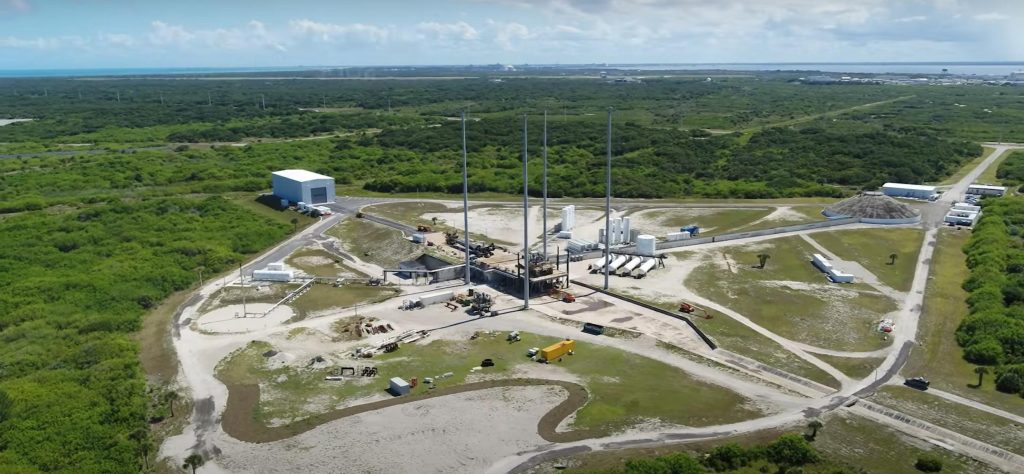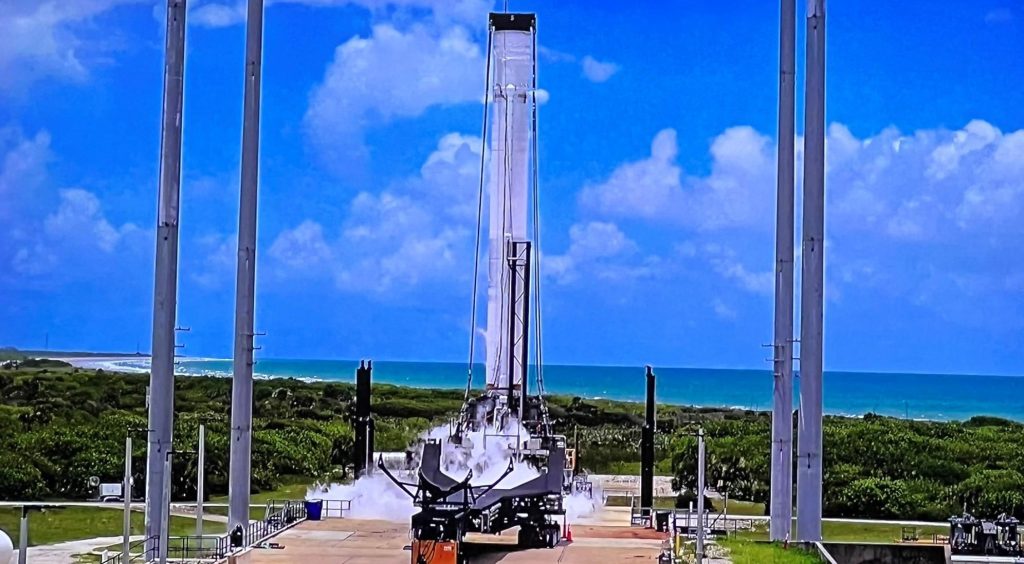

News
Relativity Space’s first 3D-printed rocket booster passes early tests
Relativity Space CEO Tim Ellis says that the startup’s first 3D-printed ‘Terran-1’ rocket booster has already completed a few significant tests after arriving at its Florida launch pad last month.
Terran-1 is an expendable two-stage launch vehicle that, when assembled for the first time, will measure around 33 meters (110 ft) tall, 2.3 meters (7.5 ft) wide, and weigh 9.3 tons (~20,500 lb) empty. Fueled by liquid oxygen and methane (methalox) and powered by nine small Aeon engines, the first Terran booster will produce around 90 tons (~200,000 lbf) of thrust at liftoff. Altogether, the rocket is designed to initially launch up to 1.25 tons (~2750 lb) to low Earth orbit, with plans to expand to 1.5 tons (~3300 lb) in the future. SpaceX’s Falcon 9, for context, measures 3.7 meters (12 ft) wide, 70 meters (~230 ft) tall, likely weighs around 30 tons (~65,000 lb) dry, and can launch 22.8 tons (~50,250 lb) to LEO in an expendable configuration. A single one of its nine Merlin 1D booster engines produces about as much thrust as the entire first stage of Terran-1.
While tiny in comparison, Terran-1’s booster is still a relatively large and powerful rocket, and testing it poses significant challenges. Instead of building a custom test stand elsewhere, Relativity has chosen to conduct almost all first-stage qualification testing at its Cape Canaveral Space Force Station (CCSFS) LC-16 pad.
That plan increases the risk of the rocket damaging Relativity’s only available launch pad, significantly delaying launch preparations, but it also has the potential to save time by doubling as a launch pad shakedown. Aside from basic concrete features and foundations, LC-16 was essentially a blank slate when Relativity arrived, so qualifying the pad – virtually all of which is new and recently installed – is no small feat on its own.

Relativity’s first Terran-1 flight hardware has performed shockingly well. The smaller single-engine upper stage sailed through a full program of proof tests – including a full-duration static fire – shortly before shipping to LC-16. Terran-1’s first booster, meanwhile, left Relativity’s California factory and arrived at LC-16 to begin its own qualification testing in early June.

On June 28th, CEO Tim Ellis revealed that the booster had already completed “pneumatic proof testing” and made it through its “first propellant loading” test less than a month after arriving at LC-16. That would be fast for the first prototype of any new orbital-class rocket, but Relativity’s Terran-1 has an extremely unique feature that makes that speed even more impressive: by mass, the vast majority (85%) of the rocket was manufactured with 3D printing. In effect, most of Terran’s airframe and tanks are just giant, continuous welds that were precisely manipulated into cylinders, domes, and more. While the rough surface finish leaves something to be desired and likely reduces the overall efficiency of the rocket’s airframe, Relativity says that the composition of the metal in its printed structures is almost identical to a more traditionally-manufactured component.
Relativity’s ultimate hope is that the technical groundwork it is laying will allow it to manufacture complex and high-performance rockets with minimal human intervention, drastically lowering production costs. One day, the descendants of those semi-autonomous factories might even be used to construct rockets and other complex machines and infrastructure on Mars or other extraterrestrial destinations.
First, though, the company needs to start successfully launching Terran-1 rockets and fully prove the concept. Up next, Relativity will likely perform a full wet dress rehearsal, a launch simulation in which the rocket is loaded with propellant and pressurized for flight. Once that step is complete, Relativity will attempt one or several static fire tests, culminating in a full-duration multi-minute static fire or “mission duty cycle.”

Cybertruck
Tesla Cybertruck undergoes interior mod that many owners wanted

Tesla Cybertruck is significantly different from traditional pickups on the market in a lot of ways. However, one feature that was recently modified with its interior was a highly requested characteristic that is present in other trucks, but was void from Cybertruck.
Tesla went with a five-seat configuration with Cybertruck: two in the front and three in the back. The spacious interior is matched with plenty of storage, especially up front, as a pass-through, center console, and other storage options, but some Tesla fans wanted something different: bench seating.
Bench seating is popular in many full-size pickups and allows three passengers to sit up front. The middle seat is usually accompanied by a fold-down storage unit with cupholders.
Tesla decided to opt for no bench seating up front, despite the fact that it equipped bench seating in the unveiling in 2019. Interior photos from the unveiling event from nearly six-and-a-half years ago show Tesla had originally planned to have a six-seat configuration.
This was adjusted after the company refined the design:

(Tesla Cybertruck interior configuration in 2019)
Despite Tesla abandoning this design, it does not mean owners were willing to accept it. One owner decided to modify their Tesla Cybertruck interior to equip that third seat between the driver’s and passenger’s thrones.
The fit is snug, and while it looks great, it is important to remember that this does not abide byregulations, as it would require an airbag to be technically legal. Please do not do this at home with your own Cybertruck:
- Credit: @blueskykites
- Credit: @blueskykites
- Credit: @blueskykites
The Cybertruck is a popular vehicle in terms of publicity, but its sales have been underwhelming since first delivered to customers back in 2023. It’s hard to believe it’s been out for two-and-a-half years, but despite this, Tesla has not been able to come through on its extensive order sheet.
This is mostly due to price, as Cybertruck was simply not as affordable as Tesla originally planned. Its three configurations were initially priced at $39,990, $49,990, and $69,990. At release, Cybertruck was priced above $100,000.
This priced out many of those who had placed orders, which is the main reason Cybertruck has not lived up to its expectations in terms of sales. The adjustments to the specific features, like the removal of the bench seat, likely did not impact sales as much as pricing did.
This modification shows some creativity by Tesla owners, but also shows that the Cybertruck could always be the subject of a potential refresh to include some of these features. Tesla routinely adjusts its vehicle designs every few years, so maybe the Cybertruck could get something like this if it chooses to refresh its all-electric pickup.
Elon Musk
Tesla CEO Elon Musk drops massive bomb about Cybercab
“And there is so much to this car that is not obvious on the surface,” Musk said.

Tesla CEO Elon Musk dropped a massive bomb about the Cybercab, which is the company’s fully autonomous ride-hailing vehicle that will enter production later this year.
The Cybercab was unveiled back in October 2024 at the company’s “We, Robot” event in Los Angeles, and is among the major catalysts for the company’s growth in the coming years. It is expected to push Tesla into a major growth phase, especially as the automaker is transitioning into more of an AI and Robotics company than anything else.
The Cybercab will enable completely autonomous ride-hailing for Tesla, and although its other vehicles will also be capable of this technology, the Cybercab is slightly different. It will have no steering wheel or pedals, and will allow two occupants to travel from Point A to Point B with zero responsibilities within the car.
Tesla shares epic 2025 recap video, confirms start of Cybercab production
Details on the Cybercab are pretty face value at this point: we know Tesla is enabling 1-2 passengers to ride in it at a time, and this strategy was based on statistics that show most ride-hailing trips have no more than two occupants. It will also have in-vehicle entertainment options accessible from the center touchscreen.
It will also have wireless charging capabilities, which were displayed at “We, Robot,” and there could be more features that will be highly beneficial to riders, offering a full-fledged autonomous experience.
Musk dropped a big hint that there is much more to the Cybercab than what we know, as a post on X said that “there is so much to this car that is not obvious on the surface.”
And there is so much to this car that is not obvious on the surface
— Elon Musk (@elonmusk) January 2, 2026
As the Cybercab is expected to enter production later this year, Tesla is surely going to include a handful of things they have not yet revealed to the public.
Musk seems to be indicating that some of the features will make it even more groundbreaking, and the idea is to enable a truly autonomous experience from start to finish for riders. Everything from climate control to emergency systems, and more, should be included with the car.
It seems more likely than not that Tesla will make the Cybercab its smartest vehicle so far, as if its current lineup is not already extremely intelligent, user-friendly, and intuitive.
Investor's Corner
Tesla Q4 delivery numbers are better than they initially look: analyst
The Deepwater Asset Management Managing Partner shared his thoughts in a post on his website.

Longtime Tesla analyst and Deepwater Asset Management Managing Partner Gene Munster has shared his insights on Tesla’s Q4 2025 deliveries. As per the analyst, Tesla’s numbers are actually better than they first appear.
Munster shared his thoughts in a post on his website.
Normalized December Deliveries
Munster noted that Tesla delivered 418k vehicles in the fourth quarter of 2025, slightly below Street expectations of 420k but above the whisper number of 415k. Tesla’s reported 16% year-over-year decline, compared to +7% in September, is largely distorted by the timing of the tax credit expiration, which pulled forward demand.
“Taking a step back, we believe September deliveries pulled forward approximately 55k units that would have otherwise occurred in December or March. For simplicity, we assume the entire pull-forward impacted the December quarter. Under this assumption, September growth would have been down ~5% absent the 55k pull-forward, a Deepwater estimate tied to the credit’s expiration.
“For December deliveries to have declined ~5% year over year would imply total deliveries of roughly 470k. Subtracting the 55k units pulled into September results in an implied December delivery figure of approximately 415k. The reported 418k suggests that, when normalizing for the tax credit timing, quarter-over-quarter growth has been consistently down ~5%. Importantly, this ~5% decline represents an improvement from the ~13% declines seen in both the March and June 2025 quarters.“
Tesla’s United States market share
Munster also estimated that Q4 as a whole might very well show a notable improvement in Tesla’s market share in the United States.
“Over the past couple of years, based on data from Cox Automotive, Tesla has been losing U.S. EV market share, declining to just under 50%. Based on data for October and November, Cox estimates that total U.S. EV sales were down approximately 35%, compared to Tesla’s just reported down 16% for the full quarter. For the first two months of the quarter, Cox reported Tesla market share of roughly a 65% share, up from under 50% in the September quarter.
“While this data excludes December, the quarter as a whole is likely to show a material improvement in Tesla’s U.S. EV market share.“











